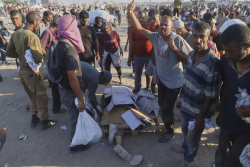As tensions rise in the Caspian region, Kazakhstan’s nonproliferation legacy and multi-vector diplomacy uniquely position it to mediate with Iran and maintain regional stability amid nuclear and economic risks.
When the world held its breath, wondering if Iran would close the straits of Hormuz in the Persian Gulf and plunge the world into economic chaos, tensions were also simmering to Iran’s north. The Caspian Sea, whose littoral states include Iran, Russia, Azerbaijan, Turkmenistan, and Kazakhstan, has long been a battlefield for geostrategic influence.
Central Asian states hope to utilize the Caspian Sea to bypass Iran and Russia via an economic artery through the Caucasus, known as the Middle Corridor. China advocates for such a route to trade with Europe without fear of American blockade. America’s interest in the route lies in its potential to isolate Iran and Russia simultaneously.
Kazakhstan’s Role in the Iran-Israel Crisis
Kazakhstan has warned of deteriorating security in the Caspian region after the United States military strikes on Iran on June 22. Russia and Iran are both embroiled in wars they are not winning, and both present a nuclear risk. The defeat, or even a pyrrhic victory, of Moscow or Tehran in either conflict risks creating conditions that could lead to saber-rattling and military confrontation, potentially triggering long-term instability throughout the Caucasus and Central Asia.
It is in the interests of Central Asian states and Western actors to maintain the tranquility of the Caspian Sea. Since the dissolution of the Soviet Union in 1991, the region has adopted a multi-vector foreign policy that seeks to balance the interests of its far more powerful neighbors by ensuring their interests are counterbalanced by other outside powers.
Since the presidency of Kazakhstan’s Nursultan Nazarbayev, these fundamental principles have become not only his legacy but the legacy of Kazakhstan and the region. These principles are unattainable if the Caspian Sea encounters geopolitical headwinds.
In this spirit, Astana has urged all relevant states to reach an agreement as soon as possible “… to prevent the proliferation of nuclear weapons and provide security guarantees for states that comply with the nonproliferation regime under international oversight.”
Central Asia Is Now a Nuclear Weapon Free Zone
Central Asia’s multi-vector foreign policy has also been applied in the realm of denuclearization. A systematic nuclear nonproliferation policy, as part of a comprehensive national security approach, facilitates outside powers’ investment in regional security on the Caspian Sea. When the Soviet Union collapsed, Kazakhstan inherited the world’s fourth-largest nuclear arsenal and one of the largest Soviet atomic testing sites.
By 1996, all of Kazakhstan’s nuclear armaments had been completely dismantled with US assistance under the Nunn-Lugar Cooperative Threat Reduction (CTR) Program. Praised by many foreign leaders, this nonproliferation policy is now enshrined in the foundations of the state policy and has become part of the country’s indelible legacy.
Kazakhstan had a tragic experience with decades of nuclear weapons testing by the Soviet regime, making it a unique interlocutor for Iran’s nuclear ambitions. Between 1949 and 1989, Moscow conducted 456 nuclear tests, including 340 underground and 116 atmospheric tests, at the Semipalatinsk Test Site near the northern city of Semey. Radiation from the blasts, which had the combined explosive power of 2,500 atomic bombs dropped on Hiroshima, caused thousands of deaths and illnesses.
Even before the collapse of the Soviet Union, Nazarbayev’s government banned all testing on Kazakh territory. It unilaterally shut down the nuclear test site on August 29, 1991, making Kazakhstan the first nation in history to permanently close a nuclear test site. Embracing the grassroots Nevada-Semipalatinsk Antinuclear Movement’s mission, Nazarbayev also launched a large-scale international advocacy campaign, the ATOM Project, aimed at banning nuclear testing globally, including through the United Nations.
Kazakhstan also took an activist stance to minimize the danger of nuclear proliferation in the surrounding area. Landlocked in a region with a concentration of nuclear powers: Russia, China, India, and Pakistan and with the possibility of Iran acquiring nuclear weapons, Kazakhstan hosted two rounds of the P5+1 nuclear talks in 2013, which, according to the US Department of State “was instrumental in the international community’s efforts to reach a diplomatic solution on the Iranian nuclear program.”
Astana also collaborated with the Atomic Energy Agency to establish a low-enriched uranium bank on its territory, supplying uranium for civilian purposes. The bank has been operational since 2017, the year when the first Trump Administration cancelled the Joint Comprehensive Plan of Action with Iran.
While Astana firmly supports the preservation and strengthening of the nonproliferation regime, it also recognizes Iran’s sovereign right to develop peaceful nuclear energy for civilian purposes under international monitoring. This nearby low-enrichment uranium bank means Iran does have a path forward for engagement with the global community.
Kazakhstan Will Keep Central Asia Safe from Nuclearization
As the leading economy in Central Asia, Kazakhstan is well-positioned to play a key role in restoring stability in the Caspian region. Since independence, the country has attracted a total of $431 billion in foreign direct investment in the mining, energy, agriculture, and finance sectors. The vast Western investments that Nazarbayev secured in the 1990s and early 2000s were crucial for the development of a modern market economy and the country’s integration into the global trade system.
Moreover, expanding its circle of stakeholders through large-scale investments by the US and Europe enhances national security and stability in times of crisis.
Building on the country’s economic achievements, President Tokayev has set a goal to double the country’s GDP to $450 billion by 2029, announcing priorities for the country’s economic growth that include new infrastructure, digitalization, and artificial intelligence, as well as modernizing agriculture and expanding the transport and logistics sectors. These policies also intend to address wealth inequalities. Kazakhstan is also seeking to attract an additional $150 billion by 2029.
Tokayev has also emphasized the importance of the Middle Corridor for diversifying transportation links. Sanctions have made exports through Russia problematic, and Astana has been investing in the development of the Middle Corridor. However, every crisis presents an opportunity, and Kazakhstan may gain new regional and international significance in the face of emerging security challenges.
Kazakhstan’s foreign policy model and its history of adhering to nonproliferation principles can help position the country as a blueprint for nuclear disarmament and a mediator for de-escalation in current conflicts. \
In a Russian-language Telegram post, political scientist Daniyar Ashimbayev recently wrote that, in the current geopolitical situation, “Kazakhstan is uniquely positioned, with logistics, trade networks, and balanced relationships with multiple powers.” The country’s multi-vector foreign policy has enabled Kazakhstan to preserve its sovereignty and economic vitality amid turbulent geopolitical headwinds. The hope is that it can build on its legacy and help neighbors return to the road toward peace.
About the Author: Margarita Assenova
Margarita Assenova is a Senior Fellow at The Jamestown Foundation. She is a regular contributor to the Jamestown publication Eurasia Daily Monitor on political and energy security developments in the Balkans and Central Asia. Follow her on X: @M_Assenova.
Image Credit: Shutterstock/lev radin.


















